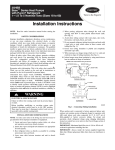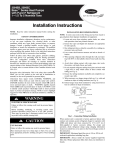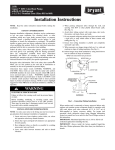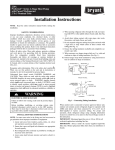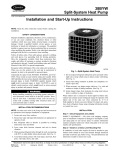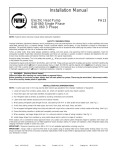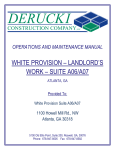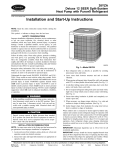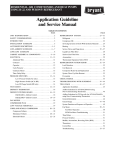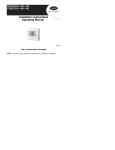Download Carrier 25HCR Air Conditioner User Manual
Transcript
25HCR COMFORTt SERIES R---22 HEAT PUMPS SIZES 18 TO 60 1---1/2 TO 5 NOMINAL TONS Installation Instructions TABLE OF CONTENTS PAGE SAFETY CONSIDERATIONS . . . . . . . . . . . . . . . . . . . . . . . 2 INSTALLATION RECOMMENDATIONS . . . . . . . . . . . . . 2 INSTALLATION . . . . . . . . . . . . . . . . . . . . . . . . . . . . . . 3 -- 10 Step 1 -- Check Equipment & Jobsite . . . . . . . . . . . . . . . 3 Step 2 -- Install on Solid Pad . . . . . . . . . . . . . . . . . . . . . . 3 Step 3 -- Clearance Requirements . . . . . . . . . . . . . . . . . . 3 Step 4 -- Operating Ambient . . . . . . . . . . . . . . . . . . . . . . 3 Step 5 -- Install TXV . . . . . . . . . . . . . . . . . . . . . . . . . 3 -- 4 Step 6 -- Check Defrost Thermostat . . . . . . . . . . . . . . . . . 4 Step 7 -- Make Piping Connections . . . . . . . . . . . . . . 4 -- 6 Step 8 -- Make Electrical Connections . . . . . . . . . . . . 6 -- 7 Step 9 -- Compressor Crankcase Heater . . . . . . . . . . . . . 7 Step 10 -- Install Electrical Accessories . . . . . . . . . . . . . . 7 Step 11 -- Start--Up . . . . . . . . . . . . . . . . . . . . . . . . . . . 7 -- 9 Step 12 -- Check Charge . . . . . . . . . . . . . . . . . . . . . . . . . 10 Step 13 -- Final Checks . . . . . . . . . . . . . . . . . . . . . . . . . . 10 CARE AND MAINTENANCE . . . . . . . . . . . . . . . . . . . . . . 10 Fig. 1 --- 25HCR A05341 NOTE: Read the entire instruction manual before starting the installation. INSTALLATION RECOMMENDATIONS NOTE: In some cases noise in the living area has been traced to gas pulsations from improper installation of equipment. 1. Locate unit away from windows, patios, decks, etc. where unit operation sound may disturb customer. 2. Ensure that vapor and liquid tube diameters are appropriate for unit capacity. 3. Run refrigerant tubes as directly as possible by avoiding unnecessary turns and bends. 4. Leave some slack between structure and unit to absorb vibration. 5. When passing refrigerant tubes through the wall, seal opening with RTV or other pliable silicon--based caulk. (See Fig. 2.) 6. Avoid direct tubing contact with water pipes, duct work, floor joists, wall studs, floors, and walls. 7. Do not suspend refrigerant tubing from joists and studs with a rigid wire or strap which comes in direct contact with tubing.(See Fig. 2.) 8. Ensure that tubing insulation is pliable and completely surrounds vapor tube. 9. When necessary, use hanger straps which are 1 in. wide and conform to shape of tubing insulation. (See Fig. 2.) 10. Isolate hanger straps from insulation by using metal sleeves bent to conform to shape of insulation. 25HCR SAFETY CONSIDERATIONS Improper installation, adjustment, alteration, service, maintenance, or use can cause explosion, fire, electrical shock, or other conditions which may cause death, personal injury, or property damage. Consult a qualified installer, service agency, or your distributor or branch for information or assistance. The qualified installer or agency must use factory--authorized kits or accessories when modifying this product. Refer to the individual instructions packaged with the kits or accessories when installing. Follow all safety codes. Wear safety glasses, protective clothing, and work gloves. Use quenching cloth for brazing operations. Have fire extinguisher available. Read these instructions thoroughly and follow all warnings or cautions included in literature and attached to the unit. Consult local building codes and National Electrical Code (NEC) for special requirements. Recognize safety information. This is the safety--alert symbol ! . When you see this symbol on the unit and in instructions or manuals, be alert to the potential for personal injury. Understand these signal words; DANGER, WARNING, and CAUTION. These words are used with the safety--alert symbol. DANGER identifies the most serious hazards which will result in severe personal injury or death. WARNING signifies hazards which could result in personal injury or death. CAUTION is used to identify unsafe practices which may result in minor personal injury or product and property damage. NOTE is used to highlight suggestions which will result in enhanced installation, reliability, or operation. ! NOTE: Avoid contact between tubing and structure WARNING OUTDOOR WALL INDOOR WALL CAULK LIQUID TUBE ELECTRICAL SHOCK HAZARD Failure to follow this warning could result in personal injury or death. VAPOR TUBE Before installing, modifying, or servicing system, main electrical disconnect switch must be in the OFF position. There may be more than 1 disconnect switch. Lock out and tag switch with a suitable warning label. INSULATION THROUGH THE WALL JOIST HANGER STRAP (AROUND VAPOR TUBE ONLY) INSULATION VAPOR TUBE 1″ MIN. LIQUID TUBE SUSPENSION Fig. 2 --- Connecting Tubing Installation A94028 When outdoor unit is connected to factory--approved indoor unit, outdoor unit contains system refrigerant charge for operation with ARI rated indoor unit when connected by 15 ft. of field--supplied or factory accessory tubing. For proper unit operation, check refrigerant charge using charging information located on control box cover and/or in the Check Charge section of this instruction. IMPORTANT: Maximum liquid--line size is 3/8--in. OD for all residential applications including line line. IMPORTANT: Always install the factory--supplied liquid--line filter drier. Obtain replacement filter driers from your distributor or branch. 2 INSTALLATION STEP 1 —Check Equipment and Job Site Unpack Unit Move to final location. Remove carton taking care not to damage unit. Inspect Equipment File claim with shipping company prior to installation if shipment is damaged or incomplete. Locate unit rating plate on unit corner panel. It contains information needed to properly install unit. Check rating plate to be sure unit matches job specifications. STEP 2 —Install on a Solid, Level Mounting Pad If conditions or local codes require the unit be attached to pad, tie down bolts should be used and fastened through knockouts provided in unit base pan. Refer to unit mounting pattern in Fig. 3 to determine base pan size and knockout hole location. For hurricane tie downs, contact distributor for details and PE Certification (Professional Engineer), if required. On rooftop applications, mount on level platform or frame. Place unit above a load--bearing wall and isolate unit and tubing set from structure. Arrange supporting members to adequately support unit and minimize transmission of vibration to building. Consult local codes governing rooftop applications. Roof mounted units exposed to winds above 5 mph may require wind baffles. Consult the Service Manual -- Residential Split System Air Conditioners and Heat Pumps for wind baffle construction. NOTE: Unit must be level to within ±2° (±3/8 in./ft.) per compressor manufacturer specifications. STEP 3 —Clearance Requirements When installing, allow sufficient space for airflow clearance, wiring, refrigerant piping, and service. Allow 30--in. clearance to service end of unit and 48 in. above unit. For proper airflow, a 6--in. clearance on 1 side of unit and 12 in. on all remaining sides must be maintained. Maintain a distance of 24 in. between units. Position so water, snow, or ice from roof or eaves cannot fall directly on unit. On rooftop applications, locate unit at least 6 in. above roof surface. STEP 4 —Operating Ambient The minimum outdoor operating ambient in cooling mode is 55°F, and the maximum outdoor operating ambient in cooling mode is 125°F. The maximum outdoor operating ambient in heating mode is 66 °F. STEP 5 —Install TXV NOTE: Applies to non--TXV indoor units only. If installing a rated and approved indoor coil without a factory installed R--22 TXV, remove and replace the fixed orifice or PuronR TXV expansion device with an R--22 TXV. ! CAUTION Failure to follow this caution may result in equipment damage or improper operation. All indoor coil units must be installed with a hard shut off R--22 TXV metering device. IMPORTANT: If not factory installed, the TXV should be mounted as close to the indoor coil as possible and in a vertical, upright position. Avoid mounting the inlet tube vertically down. Valve is more susceptible to malfunction due to debris if inlet tube is facing down. A factory--approved filter drier must be installed in the liquid line. Installing TXV in Place of Piston 1. Pump system down to 2 psig and recover refrigerant. 2. Remove hex nut from piston body. Use backup wrench on fan coils. 3. Remove and discard factory--installed piston. Be sure Teflon seal is in place. 4. Reinstall hex nut. Finger tighten nut plus 1/2 turn. NOTE: If the piston is not removed from the body, TXV will not function properly. 3/8 ---in. Dia. Tiedown Knockouts in Basepan (2) Places ! CAUTION EQUIPMENT DAMAGE HAZARD Failure to follow this caution may result in equipment damage or improper operation. Use a brazing shield and wrap TXV with wet cloth or use heat sink material. 5. Install TXV on indoor coil liquid line. Sweat swivel adapter to inlet of indoor coil and attach to TXV outlet. Use backup wrench to avoid damage to tubing or valve. Sweat inlet of TXV, marked “IN” to liquid line. Avoid excessive heat which could damage valve. 6. Install vapor elbow with equalizer adapter to suction tube of line set and suction connection to indoor coil. Adapter has a 1/4--in. male connector for attaching equalizer tube. 7. Connect equalizer tube of TXV to 1/4--in. equalizer fitting on vapor line adapter. 8. Attach TXV bulb to horizontal section of suction line using clamps provided. Insulate bulb with field--supplied insulation tape. See Fig. 4 for correct positioning of sensing bulb. 9. Proceed with remainder of unit installation. View From Top UNIT BASE PAN DIMENSIONS TIEDOWN KNOCKOUT LOCATIONS A B C 26 X 26 9–1/8 4–7/16 21–1/4 31–1/2 X 31–1/2 9–1/8 6–9/16 24–11/16 35 X 35 9–1/8 6–9/16 28–7/16 Fig. 3 --- Clearance Requirements A05177 3 25HCR UNIT OPERATION HAZARD STEP 6 —Check Defrost Thermostat Check defrost thermostat to ensure it is properly located and securely attached. There is a liquid header with a brass distributor and feeder tube going into outdoor coil. At the end of the one of the feeder tubes, there is a 3/8 in. O.D. stub tube approximately 2 in. long. (See Fig. 5.) The defrost thermostat should be located on stub tube. Note that there is only one stub tube used with liquid header, and on most units it is the bottom circuit. 10 O'CLOCK 2 O'CLOCK SENSING BULB STRAP SUCTION TUBE 8 O'CLOCK 7⁄ 8 IN. OD & SMALLER FEEDER TUBE 4 O'CLOCK LARGER THAN 25HCR Fig. 4 --- Position of Sensing Bulb 7⁄8 STUB TUBE IN. OD A81032 Replacing TXV on Puron Indoor Coil 1. Pump system down to 2 psig and recover refrigerant. 2. Remove coil access panel and fitting panel from front of cabinet. 3. Remove TXV support clamp using a 5/16--in. nut driver. Save the clamp. 4. Remove Puron TXV using a backup wrench on flare connections to prevent damage to tubing. 5. Using wire cutters, cut equalizer tube off flush with vapor tube inside cabinet. 6. Remove bulb from vapor tube inside cabinet. 7. Braze equalizer stub--tube closed. Use protective barrier as necessary to prevent damage to drain pan. IMPORTANT: Route the equalizer tube of R--22 TXV through suction line connection opening in fitting panel prior to replacing fitting panel around tubing. 8. Install TXV with 3/8--in. copper tubing through small hole in service panel. Use wrench and backup wrench, to avoid damage to tubing or valve, to attach TXV to distributor. 9. Reinstall TXV support clamp (removed in item 3). 10. Attach TXV bulb to vapor tube inside cabinet, in same location as original was when removed, using supplied bulb clamps (nylon or copper). See Fig. 4 for correct positioning of sensing bulb. 11. Route equalizer tube through suction connection opening (large hole) in fitting panel and install fitting panel in place. 12. Sweat inlet of TXV, marked IN to liquid line. Avoid excessive heat which could damage valve. 13. Install vapor elbow with equalizer adapter to vapor line of line set and vapor connection to indoor coil. Adapter has a 1/4--in. male connector for attaching equalizer tube. 14. Connect equalizer tube of TXV to 1/4--in. equalizer fitting on vapor line adapter. Use backup wrench to prevent damage to equalizer fitting. 15. Proceed with remainder of unit installation. DEFROST THERMOSTAT Fig. 5 --- Defrost Thermostat Location A97517 STEP 7 —Make Piping Connections WARNING ! PERSONAL INJURY AND ENVIRONMENTAL HAZARD Failure to follow this warning could result in personal injury or death. Relieve pressure and recover all refrigerant before system repair or final unit disposal. Use all service ports and open all flow--control devices, including solenoid valves. ! CAUTION UNIT DAMAGE HAZARD Failure to follow this caution may result in equipment damage or improper operation. If ANY refrigerant tubing is buried, provide a 6--in. vertical rise at service valve. Refrigerant tubing lengths up to 36--in. may be buried without further special consideration. Do not bury lines longer than 36 in. ! CAUTION UNIT DAMAGE HAZARD Failure to follow this caution may result in equipment damage or improper operation. To prevent damage to unit or service valves, observe the following: S Use a brazing shield S Wrap service valves with wet cloth or use a heat sink material. 4 Remove plastic retainer holding outdoor piston in liquid service valve, leaving the piston and piston retainer inside the valve. Connect sweat/flare adapter provided, to valve. (See Fig. 6.) Connect refrigerant tubing to fittings on outdoor unit vapor and liquid service valves. Service valves are closed from factory and ready for brazing. After wrapping service valve with a wet cloth, tubing set can be brazed to service valve using either silver bearing or non--silver bearing brazing material. Do not use soft solder (materials which melt below 800°F). Consult local code requirements. Refrigerant tubing and indoor coil are now ready for leak testing. This check should include all field and factory joints. Outdoor units may be connected to indoor section using accessory tubing package or field--supplied refrigerant grade tubing of correct size and condition. For tubing requirements beyond 80 ft., substantial capacity and performance losses can occur. Following the recommendations in the Application Guideline and Service Manual--Residential Split--System Air Conditioners and Heat Pumps will reduce these losses. Refer to Table 1 for accessory requirements. Refer to Table 2 for field tubing diameters. There are no buried--line applications greater than 36 in. If refrigerant tubes or indoor coil are exposed to atmosphere, they must be evacuated to 500 microns to eliminate contamination and moisture in the system. Outdoor Unit Connected to Factory--Approved Indoor Unit Outdoor unit contains correct system refrigerant charge for operation with approved ARI rated indoor unit when connected by 15 ft. of field--supplied or factory--accessory tubing, and factory supplied filter drier. Check refrigerant charge for maximum efficiency. Refrigerant Tubing and Sweat Connections Connect vapor tube to fitting on outdoor unit vapor service valves (see Table 2). Connect liquid tubing to adapter tube on liquid service valve. Use refrigerant grade tubing. 25HCR PISTON BODY PISTON PISTON RETAINER CAUTION ! SWEAT/FLARE ADAPTER UNIT DAMAGE HAZARD Failure to follow this caution may result in equipment damage or improper operation. Fig. 6 --- Liquid Service Valve Service valves must be wrapped in a heat--sinking material such as a wet cloth while brazing. A05226 Table 1—Accessory Usage Crankcase Heater REQUIRED FOR LOW---AMBIENT APPLICATIONS (Below 55 °F) Yes Evaporator Freeze Thermostat Yes Winter Start Control Yes Accessory REQUIRED FOR LONG LINE APPLICATIONS* (Over 80 ft.) Yes Accumulator No Compressor Start Assist Capacitor and Relay Yes Support Feet Recommended No No No Yes No Liquid Line Solenoid Valve No See Long --- Line Application Guideline * For Tubing Set lengths between 80 and 200 ft. horizontal or 20 ft. vertical differential (250 ft. Total Equivalent Length), refer to the Long Line Guidelines for Air Conditioners and Heat Pumps using R---22. Table 2—Refrigerant Connections and Recommended Liquid and Vapor Tube Diameters (in.) UNIT SIZE 018, 024 030, 036 042, 048 060 LIQUID VAPOR (up to 80 ft.*) Connection Diameter Tube Diameter Connection Diameter Rated Tube Diameter 3/8 3/8 3/8 3/8 3/8 3/8 3/8 3/8 5/8 3/4 7/8 7/8 5/8 3/4 7/8 1-- 1/8 Notes: 1. Tube diameters are for total equivalent lengths up to 80 ft.. 2. Do not apply capillary tube or fixed orifice indoor coils to these units. * For Tubing Set lengths between 80 and 200 ft. horizontal or 20 ft. vertical differential (250 ft.Total Equivalent Length), refer to the Longline Guideline --- Air Conditioners and Heat Pumps using R---22 5 STEP 8 —Make Electrical Connections IMPORTANT: Check to be certain factory tubing on both indoor and outdoor unit has not shifted during shipment. Ensure tubes are not rubbing against each other or any sheet metal. Pay close attention to feeder tubes, makings sure wire ties on feeder tubes are secure and tight. Be sure field wiring complies with local and national fire, safety, and electrical codes, and voltage to system is within limits shown on unit rating plate. Contact local power company for correction of improper voltage. See unit rating plate for recommended circuit protection device. NOTE: Operation of unit on improper line voltage constitutes abuse and could affect unit reliability. See unit rating plate. Do not install unit in system where voltage may fluctuate above or below permissible limits. 25HCR ! WARNING ! ELECTRICAL SHOCK HAZARD Failure to follow this warning could result in personal injury or death. Do not supply power to unit with compressor terminal box cover removed. NOTE: Use copper wire only between disconnect switch and unit. NOTE: Install branch circuit disconnect of adequate size per NEC to handle unit starting current. Locate disconnect within sight from and readily accessible from unit, per Section 440--14 of NEC. Route Ground and Power Wires Remove access panel to gain access to unit wiring. Extend wires from disconnect through power wiring hole provided and into unit control box. Connect Ground and Power Wires Connect ground wire to ground connection in control box for safety. Connect power wiring to contactor as shown in Fig. 8. CAUTION UNIT DAMAGE HAZARD Failure to follow this caution may result in equipment damage or improper operation. Installation of filter drier in liquid line is required. Install Liquid Line Filter Drier Indoor Refer to Fig. 7 and install filter drier as follows: 1. Braze 5 in. liquid tube to the indoor coil. 2. Wrap filter drier with damp cloth. 3. Braze filter drier to 5 in. long liquid tube from step 1. 4. Connect and braze liquid refrigerant tube to the filter drier. WARNING ! ELECTRICAL SHOCK HAZARD Failure to follow this warning could result in personal injury or death. The unit cabinet must have an uninterrupted or unbroken ground to minimize personal injury if an electrical fault should occur. The ground may consist of electrical wire or metal conduit when installed in accordance with existing electrical codes. Connect ground wire to ground connection in control box for safety. Connect power wiring to contactor as shown in Fig. 8. DISCONNECT PER N. E. C. AND/OR LOCAL CODES CONTACTOR FIELD POWER WIRING Fig. 7 --- Liquid Line Filter Drier FIELD GROUND A05227 WIRING GROUND LUG Fig. 8 --- Line Connections 6 A94025 STEP 11 —Start--Up Connect Control Wiring Route 24v control wires through control wiring grommet and connect leads to control wiring. See Thermostat Installation Instructions for wiring specific unit combinations. (See Fig. 9.) Use No. 18 AWG color--coded, insulated (35°C minimum) wire. If thermostat is located more than 100 ft. from unit, as measured along the control voltage wires, use No. 16 AWG color--coded wire to avoid excessive voltage drop. All wiring must be NEC Class 1 and must be separated from incoming power leads. Use furnace transformer, fan coil transformer, or accessory transformer for control power, 24v/40va minimum. NOTE: Use of available 24v accessories may exceed the minimum 40va power requirement. Determine total transformer loading and increase the transformer capacity or split the load with an accessory transformer as required. Final Wiring Check IMPORTANT: Check factory wiring and field wire connections to ensure terminations are secured properly. Check wire routing to ensure wires are not in contact with tubing, sheet metal, etc. STEP 9 —Compressor Crankcase Heater When equipped with a crankcase heater, furnish power to heater a minimum of 24 hr before starting unit. To furnish power to heater only, set thermostat to OFF and close electrical disconnect to outdoor unit. A crankcase heater is required if refrigerant tubing is longer than 80 ft. Refer to the Long Line Guideline--Residential Split--System Air Conditioners and Heat Pumps. STEP 10 —Install Electrical Accessories Refer to the individual instructions packaged with kits or accessories when installing. ! CAUTION PERSONAL INJURY HAZARD Failure to follow this caution may result in personal injury. Wear safety glasses, protective clothing, and gloves when handling refrigerant and observe the following: S Front seating service valves are equipped with Schrader valves. CAUTION ENVIRONMENTAL HAZARD Failure to follow this caution may result in environmental damage. Federal regulations require that you do not vent refrigerant to the atmosphere. Recover during system repair or final unit disposal. ! CAUTION UNIT OPERATION AND SAFETY HAZARD Failure to follow this caution may result in minor personal injury, equipment damage or improper operation. To prevent compressor damage or personal injury, observe the following: S Do not overcharge system with refrigerant. S Do not operate unit in a vacuum or at negative pressure. S Do not disable low pressure switch in scroll compressor applications. S Dome temperatures may be hot. Follow these steps to properly start up system: 1. After system is evacuated, fully open liquid and vapor service valves. 2. Unit is shipped with valve stem(s) front seated (closed) and caps installed. Replace stem caps after system is opened to refrigerant flow (back seated). Replace caps finger--tight and tighten with wrench an additional 1/12 turn. 3. Close electrical disconnects to energize system. 4. Set room thermostat at desired temperature. Be sure set point is below indoor ambient temperature. 5. Set room thermostat to HEAT or COOL and fan control to ON or AUTO mode, as desired. Operate unit for 15 minutes. Check system refrigerant charge. 7 25HCR ! HP THERMOSTAT 24 VAC HOT R R R 24 VAC COM C C C W2 * W2 HEAT STAGE 2 25HCR HEAT PUMP TYPICAL FAN COIL COOL/HEAT STAGE 1 Y INDOOR FAN G RVS COOLING O EMERGENCY HEAT E E W2 * Y W3 * G O * IF AVAILABLE LEGEND 24-V FACTORY WIRING 24-V FIELD WIRING FIELD SPLICE CONNECTION ODT OUTDOOR THERMOSTAT EHR EMERGENCY HEAT RELAY SHR SUPPLEMENTAL HEAT RELAY A02325 / A97413 Fig. 9 --- Generic Wiring Diagrams (See Thermostat Installation Instructions for specific unit combinations) OF1 DFT OF2 T2 C C O T1 Y O R W2 Y C P1 30 30 60 120 60 P3 ON DFT QUIET SHIFT 90 INTERVAL TIMER OFF J1 SPEEDUP Speedup Pins HK32EA003 Quiet Shift Defrost interval DIP switches Fig. 10 --- Defrost Control 8 A05378 Quiet Shift Quiet shift is a field selectable defrost mode (factory set to OFF), which will eliminate occasional noise that could be heard at the start of defrost cycle and restarting of heating cycle. It is selected by placing DIP switch 3 on defrost board (see Fig. 12) in the ON position. When Quiet Shift switch is placed in ON position, and a defrost is initiated, the following sequence of operation will occur. Reversing valve will energize, compressor will turn off for 30 seconds, and then turn back on to complete defrost. At the start of heating after conclusion of defrost, reversing valve will de--energize, compressor will turn off for another 30 seconds, and the fan will turn off for 40 seconds, before starting in the heating mode. Defrost The defrost control is a time/temperature control which has field selectable settings of 30, 60, 90, or 120 minutes, factory set to 90 minutes. These settings represent the amount of time that must pass after closure of the defrost thermostat before the defrost sequence begins. The defrost thermostat senses coil temperature throughout the heating cycle. When the coil temperature reaches the defrost thermostat setting of approximately 32 degrees F, it will close, which energizes the DFT terminal and begins the defrost timing sequence. When the DFT has been energized for the selected time, the defrost cycle begins. Defrost cycle is terminated when defrost thermostat opens, or automatically after 10 minutes. Defrost Speedup To initiate a forced defrost, speedup pins (J1) must be shorted with a flat head screwdriver for 5 seconds and RELEASED. If the defrost thermostat is open, a short defrost cycle will be observed (actual length depends on Quiet Shift switch position). When Quiet Shift is off, only a short 30 second defrost cycle is observed. With Quiet Shift ON, the speedup sequence is one minute; 30 second compressor off period followed by 30 seconds of defrost with compressor operation. When returning to heating mode, the compressor will turn off for an additional 30 seconds and the fan for 40 seconds. If the defrost thermostat is closed, a complete defrost cycle is initiated. If the Quiet Shift switch is turned on, the compressor will be turned off for two 30 second intervals as explained previously. NOTE: If the indoor blower off delay is enabled, it will run up to an additional 90 seconds to increase system efficiency. Heating On a call for heating, thermostat makes circuits R--Y and R--G. Circuit R--Y sends low voltage through the safeties and energizes the T1 terminal on the circuit board. T1 energizes the defrost logic circuit. If the compressor has been off for 5 minutes, or power has not been cycled for 5 minutes, the OF2 relay and T2 terminal will energize. This will close the contactor, start the outdoor fan motor and compressor. When the cycle is complete, R--Y is turned off , stopping the compressor and outdoor fan. The 5 minute time guard begins counting. Compressor will not come on again until this time delay expires. In the event of a power interruption, the time guard will not allow another cycle for 5 minutes. 9 25HCR Sequence of Operation NOTE: Defrost control board is equipped with 5 minute lockout timer that is initiated upon any interruption of power. Turn on power to indoor and outdoor units. Transformer is energized. Cooling On a call for cooling, thermostat makes circuits R--O, R--Y, and R--G. Circuit R--O energizes reversing valve, switching it to cooling position. Circuit R--Y sends low voltage through the safeties and energizes the T1 terminal on the circuit board. If the compressor has been off for 5 minutes, or power has not been cycled for 5 minutes, the OF2 relay and T2 terminal will energize. This will close the contactor, and start the outdoor fan motor and compressor. When the cycle is complete, R--Y is turned off, stopping the compressor and outdoor fan. The 5 minute time guard begins counting. Compressor will not come on again until this delay expires. In the event of a power interruption, the time guard will not allow another cycle for 5 minutes. 25HCR STEP 12 —Check Charge Factory charge and charging method are shown on unit rating plate. To check charge in cooling mode, refer to Cooling Only Procedure. To check charge in heating mode, refer to Heating Check Chart Procedure. Cooling Only Procedure NOTE: If subcooling charging conditions are not favorable, charge must be weighed in accordance with unit rating plate, ±0.6 oz./ft. of 3/8--in. liquid line above or below 15 ft., respectively. Favorable conditions fall within the ranges given on the charging chart on the outdoor unit plate. This system requires charging by the subcooling method. 1. Operate unit a minimum of 10 minutes before checking charge. 2. Measure liquid service valve pressure by attaching an accurate gage to service port. 3. Measure liquid line temperature by attaching an accurate thermistor type or electronic thermometer to liquid line near outdoor coil. 4. Refer to unit rating plate for required subcooling temperature. 5. Refer to Table 3. Find the point where required subcooling temperature intersects measured liquid service valve pressure. 6. To obtain required subcooling temperature at a specific liquid line pressure, add refrigerant if liquid line temperature is higher than indicated or reclaim refrigerant if temperature is lower. Allow a tolerance of ± 3°F. Heating Check Chart Procedure To check system operation during heating cycle, refer to the Heating Check Chart on outdoor unit. This chart indicates whether a correct relationship exists between system operating pressure and air temperature entering indoor and outdoor units. If pressure and temperature do not match on chart, system refrigerant charge may not be correct. Do not use chart to adjust refrigerant charge. STEP 13 —Final Checks IMPORTANT: Before leaving job, be sure to do the following: 1. Ensure that all wiring is routed away from tubing and sh eet m et al ed g es t o p rev en t ru b -- t h ro u g h o r w i re pinching. 2. Ensure that all wiring and tubing is secure in unit before adding panels and covers. Securely fasten all panels and covers. 3. Tighten service valve stem caps to 1/12--turn past finger tight. 4. L eav e U sers M an u al w i t h o w n er. E x p l ai n sy st em operation and periodic maintenance requirements outlined in manual. 5. Fill out Dealer Installation Checklist and place in customer file. Copyright 2006 Carrier Corp. S 7310 W. Morris St. S Indianapolis, IN 46231 Table 3—Required Liquid--Line Temperature Liquid Pressure at Service Valve Required Subcooling Temperature (°F) (PSIG) 5 10 15 20 134 71 66 61 56 141 74 69 64 59 148 77 72 67 62 156 80 75 70 65 163 83 78 73 68 171 86 81 76 71 179 89 84 79 74 187 92 87 82 77 196 95 90 85 80 205 98 93 88 83 214 101 96 91 86 223 104 99 94 89 233 107 102 97 92 243 110 105 100 95 253 113 108 103 98 264 116 111 106 101 274 119 114 109 104 285 122 117 112 107 297 125 120 115 110 309 128 123 118 113 321 131 126 121 116 331 134 129 124 119 346 137 132 127 122 359 140 135 130 125 CARE AND MAINTENANCE For continuing high performance and to minimize possible equipment failure, periodic maintenance must be performed on this equipment. Frequency of maintenance may vary depending upon geographic areas, such as coastal applications. See Users Manual for information. Printed in U.S.A. Edition Date: 02/06 Manufacturer reserves the right to change, at any time, specifications and designs without notice and without obligations. 10 Catalog No: 25HCR-- 2SI Replaces: 25HCR--1SI










